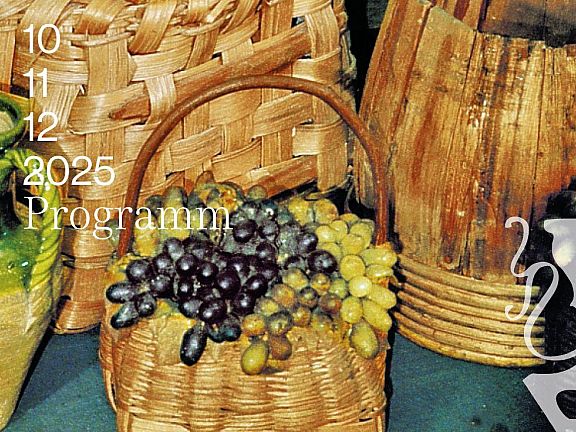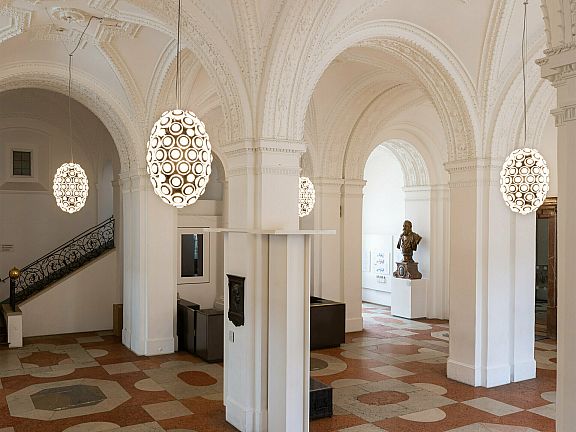Search
The ceramic collection at the Bayerisches Nationalmuseum is world renowned due to its outstanding assembly of early porcelain (see Porcelain), Italian majolica and German faience…
In the 19th century, stoves in the form of standing and sitting life-size women and men became popular in rural areas of Bavaria, Austria and southwestern Germany. While fully…
Blue-glazed jugs were considered pure luxury in the 17th and 18th centuries, especially in rural Bavarian households, and only the wealthiest farmers and officials could afford…
…because mass-produced earthenware and porcelain began to displace traditional everyday ceramics. A change in the range of objects seemed to offer them a way out. Functional…
The vessel is typical of the regional style of a bowl used for serving sauerkraut, but there is much more to it than that. The figurative painting on the base of the bowl shows a…
Trompe l'oeil dishes were real eye-catchers on the courtly dining table. These dishes in the form of animals, vegetables or fruit were modelled deceptively real in faience or…
Not only does the piggy bank's size and shape make an impression on us, also the skill in which it was made is remarkable. The potter turned the clay up on the wheel like a flask,…
Duke Albrecht V of Bavaria was an avid collector and used his extensive connections to acquire high-level works of art This includes a Faenza maiolica service dated 1576, one of…
The little porcelain box mounted in pure gold containing a perfume set is one of the most exquisite products of Viennese Du Paquier Porcelain Factory. It originally came from the…
In Europe the mystery behind making porcelain was only unveiled around 1707/08 in Meissen. It was called the Arcanum and was closely guarded secret. This case is a unique document…
Many of the precious porcelains at the Bayerisches Nationalmuseum originally came from the Wittelsbach court and can be traced back to the 18th century. Due to their family…
These two vases form the dazzling highlight in the permanent collection dedicated to art during the reign of King Ludwig I of Bavaria. The monarch and his consort Therese are…
In 1810, Crown Prince Ludwig of Bavaria ordered a dessert service from the Nymphenburg Porcelain Factory with copies based on the 'most exquisite paintings' in the Royal Gallery -…
Nearly life-size, this porcelain bust is an intimate portrait of Count Sigmund von Haimhausen (1708-1793). He was the founding president of the Bavarian Academy of Sciences, chief…
The sixteen comedy figures by the Nymphenburg modeller Franz Anton Bustelli are among the most beautiful porcelain figurines of the Rococo period. The highly gracefully composed…
In the 18th century, Parisian luxury goods retailers created a new fashion. They had combined various luxury goods, including Meissen porcelain figures, with fire-gilded bronze…
This precious chess set made of Meissen porcelain was obtained from the Munich Residenz and was either used at the electoral court or presented decoratively. The centre of the…
…great popularity as showpieces in bourgeois circles in the 19th century. The richness of detail of this figure is remarkable, and its range of ceramics includes bowls, jugs and…
The Bayerisches Nationalmuseum on the Prinzregentenstrasse in Munich is one of the largest museums in Germany. It displays exceptional art from late antiquity up to art nouveau as…
…Treasury, (Regensburg) Dr Raphael Beuing waffen@bayerisches-nationalmuseum.de Ceramics (porcelain and faience) Branch museum: Meißener Porzellansammlung Stiftung Ernst…
In addition to collecting, preserving and mediating art, the traditional core activities of the Bayerisches Nationalmuseum are made up of the research in art and cultural history…
…as the "Keramikmuseum Obernzell". The exhibition focused on the production and use of ceramics from the Stone Age to the present day. With the support of the special investment…






















